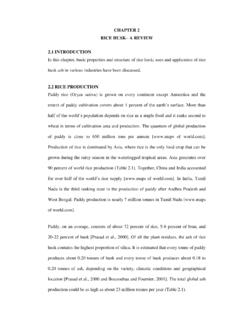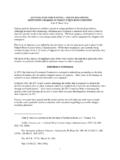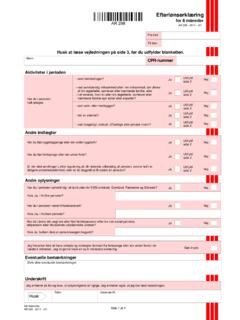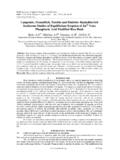Transcription of Silicon tetrachloride production by chlorination …
1 Journal of Materials Processing Technology 141 (2003) 351 356 Silicon tetrachloride production by chlorination methodusing rice husk as raw Seo , M. Andreoli, R. ChibaInstituto de Pesquisas Energ ticas e Nucleares IPEN/CNEN-SP, Centro de Tecnologia de Materiais, Cidade Universit ria, S o Paulo, BrazilReceived 3 July 2001; received in revised form 2 April 2002; accepted 10 February 2003 AbstractThe rice husk is a by-product of the rice processing that contains substantially silica and carbon compounds. For this reason, it has beenused as raw material to obtain Silicon tetrachloride employed in several kinds of industry applications. This paper presents the characteristicsof the carbonized rice husk powders and pellets as well as the SiO2/C mass relation contained in these materials. Results showed that theaddition of graphite caused the decreasing of the chlorination reaction kinetic. The best reaction yield was attained at about 1100 C. Itwas also evaluated the influence of parameters such as chlorination catalysts, bed height and chlorine gas concentration.
2 The presence ofthe catalyst had no significant effect on the chlorination reaction kinetic. Higher silica conversions were obtained by decreasing of the bedheight. 2003 Published by Elsevier Science : chlorination ; Silica; Silicon tetrachloride ; Rice husk ; Kinetics1. IntroductionThe chlorination method has been used to obtain highpurity materials, such as solar and electronic grade Silicon ( Si), Silicon oxide ( Si) and siliconnitride-based ceramics ( Si), due to the high purifi-cation efficiency of the products (in the range of ppb) byfractional distillation. The main products are Silicon tetra-chloride and chlorosilans. In chlorination reactions, it canbe employed as raw materials: Silicon oxide using carbonas reducing agent (SiO2+C), metallurgical grade Silicon (Si-MG), Silicon carbide (SiC) or Silicon metal alloys (FeSi). Silicon tetrachloride and chlorosilans have been employedas by-products in several fields like electronic, telecommu-nications and metallurgy.
3 These products can be also usedas advanced ceramics and in chemical and automotive in-dustries, mainly on the manufacture of optical fibres, cut-ting tools, components of internal combustion engines, highspeed ball bearings, mechanical seals, photovoltaic cells, in-tegrated circuits, transistors, thyristors and routes for the Silicon tetrachloride production havebeen reported in the literature, including the silica chlorina- Corresponding author. Tel.:+55-11-3816-9364;fax:+ Seo).tion using carbon and chlorine gas as reducing and chlori-nating agent, respectively[1 3].The present paper describes the chlorination processesusing rice husk , as raw material, due to its chemical com-position. The rice husk is constituted mainly by silica andcarbon, originated from the thermal decomposition of cellu-lose chains. As it can be verified in the literature, the silicaand carbon contents in a carbonized rice husk are 55 and45 , respectively. The C/Si ratio is 4/1[4].
4 The rice husk has been considered attractive for the prepa-ration of several materials such as Silicon carbide whiskers[5 7], Silicon nitride[8,9], solar grade Silicon [4,10 12]andconcrete and cements for surfacing[13 16].In this context, this paper presents the characterization ofthe rice husk powders and pellets and the chlorination kineticstudies. It was studied the influence of parameters, such astemperature, reducing agent, catalysts and bed height, on thekinetic of the chlorination Experimental procedureSamples of carbonized rice husk pellets ( =3 5 mm)were weighted to obtain an established bed height and in-troduced into the reactor previously filled with argon. Bythe time the test temperature was reached, the argon was re-placed for the chlorine gas at prefixed conditions: gas flow of0924-0136/$ see front matter 2003 Published by Elsevier Science (03) Seo et al. / Journal of Materials Processing Technology 141 (2003) 351 356 Table 1 Experimental conditions of the chlorination processParameterConditionsTemperature ( C)700, 900, 1100 Bed and height (mm)5 and l/min at a pressure of 1 atm for a dwell time of 5 50 the end of the chlorination test, chlorine gas flow was in-terrupted and substituted by argon gas.
5 The argon flow wasmaintained for 10 15 min and used to cool the samples andto purge the chlorination line. Finally, the bed was removedfrom the furnace and cooled in a desiccator. Quantitativeanalyses were 1shows the experimental conditions employed inthe chlorination fraction of converted Silicon ( ), as a function of thetime, was determined using the following equation: =m0 SiO2 mSiO2m0 SiO2(1)wherem0 SiO2is the initial mass of the rice husk pellets(SiO2+C) (g);mSiO2the mass of the rice husk pellets(SiO2+C), at a specific reaction time (g).The experimental setup, used in the chlorination tests, ispresented schematically inFig. 1. Schematic representation of the experimental Results and Rice husk powder and pellets characterizationThe rice husk specimen, that was leached with HCl (1 N)and carbonized at 500 C, was characterized by X-ray fluo-rescence analyses to determine the metallic impurities con-tents. Results are shown inTable 2. It can be observed thatP, Ca, Fe and K were the elements found at higher con-centrations.
6 The Silicon content was at about 99 TheSiO2/C mass relation, calculated from three calcination testsat 900 C, was This value is below the stoichiometricproportion necessary for the reaction to take characteristics of the powder (size<105 m)were evaluated as a function of surface area values obtainedby gas adsorption technique (BET), real density values de-termined by helium gas picnometry and granulometric dis-tribution performed by sedimentation analysis (X-ray Sedi-graph). The results were the following: 200 m2/g, g/cm3and 77 m (agglomerate mean size), patterns of the rice husk sample, treated with dis-tilled water and HCl (1 N), are presented inFig. that no crystalline phase was found. The presenceof the amorphous structure contributes to the improvementof the chlorination reaction 3shows the powder morphology of the rice huskcarbonized at 500 C, obtained by scanning electron mi-croscopy (SEM). It can be observed that the granules are ex-tremely porous.
7 According to Rodrigues and Martins[17], Seo et al. / Journal of Materials Processing Technology 141 (2003) 351 356353 Table 2 Chemical composition of the carbonized rice huskSiP (%) Ca (%) Fe (%) K (%) S (ppm) Na (ppm) Cr (ppm) Zn (ppm) Ni (ppm) Ti (ppm) Mn (ppm) Al (ppm) Cu (ppm) Mg (ppm) Zr (ppm)Base 2. X-ray patterns of the rice husk specimen (SiO2+C) carbonizedat 500 C, without graphite 3. SEM micrograph of the rice husk , carbonized at 500 presence of high porosity is a typical feature of samplesthat contain no organic polymers. This characteristic favoursthe chlorination it can be observed inFig. 4, the pellets with diametersin a range of 3 5 mm are also quite porous. This kind ofrice husk pellets benefits the chlorination rice husk pellets, mentioned above, were submittedto the chlorination , according to the reaction:SiO2+2C+2Cl2 SiCl4+2CO(2) Influence of parameters, such as reducing agentconcentration, temperature, bed height and catalysts, onthe chlorination reaction kineticIn gas solid reactions, that involve two different solidsand a gas, the mass relation between these two solids is animportant variable in a kinetic study.
8 For this reason, if theFig. 4. SEM micrograph of a rice husk reducing agent was solid, as in the present paper,the influence of its concentration should be study has to consider some changes that could inter-fere in the interpretation of the experimental results. Thesestatements are related to the differences between the twosolids (density values and crystalline structures), caused bythe graphite addition. The graphite contents were approxi-mately 30 and 50 , as a function of the initial mass ofcarbonized rice husk (SiO2+C).In reducing chlorination reactions, an increase in the re-ducing agent concentration results in the increasing of theinitial reaction speed until a maximum value is reached. Onthe other hand, additional increases could lead to the reactionspeed decrease. This behaviour is typical for tests carriedout in fixed bed, due to the optimum contact area betweenthe solids, per unit of volume[18,19]. chlorination experiments were performed using three dif-ferent sets of samples: without graphite addition, with 30and 50 in excess of graphite.
9 Reactions took place ina temperature range of 700 1100 C for 30 min, employingchlorine flow of l/min and a bed height of 5 5shows that higher SiO2conversions were attained with spec-imens without graphite addition. The carbon content of thesepellets was only that contained in the rice husk . The pow-ders presented an amorphous phase. With reference to thesamples with excess of carbon, it can be noticed that nosignificant changes occurred on silica conversion values attemperatures below 1100 C. The increasing of the reduc-ing agent content caused lower conversions due to the crys-tallinity difference between the carbon contained in the ricehusk and the graphite. Ojeda et al.[20]have been studiedthe effect of reducing agent on the MoO3chlorination. Itwas observed that the use of carbon black as reducing agentin a MoO3/C ratio different from the molar relation (1/3 Seo et al. / Journal of Materials Processing Technology 141 (2003) 351 356 Fig.)
10 5. Effect of the reducing agent concentration on the kinetic ) causes the decreasing of the MoO3conversion paper presented by Mezzavilla et al.[21]shows that thereducing agent affects strongly the conversion values onlyfor the chlorination tests using NiO and CuO at 800 C. Itwas verified that an increasing in the carbon amount exertsno significant influence mainly at 1000 C. These results arevery similar to those obtained in the present paper[21].The effect of the bed height on reaction kinetic was eval-uated using the following experimental conditions: temper-ature in a range of 700 1100 C, dwell time of 30 min,chlorine flow of l/min, bed height of 5 and 10 mm withbed porosity of and , respectively. Results arepresented inFig. 6. It was considered that the small bedheight was the responsible for the high silica conversion ob-tained for the sample containing SiO2+C. Although thebed porosities were quite similar for the bed height of 5 and10 mm, it was observed that the amount of converted silicawas proportional to the increasing in the reaction tempera-Fig.








